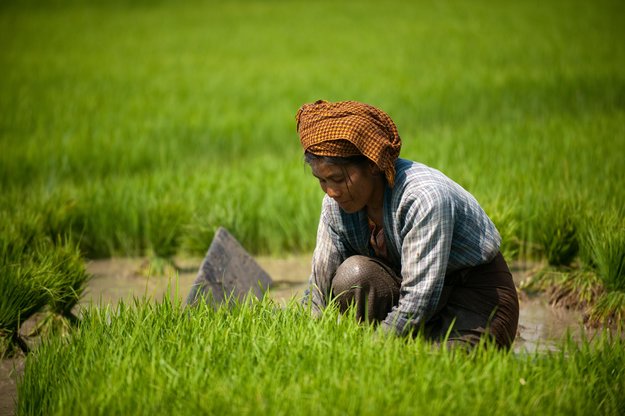In an interaction in the APAN session in Columbo, panelists discussed the intricacies of involving the cross cutting issues related to gender, in the development discourse.
A well-meaning Swedish NGO provided cash injections to women after a typhoon in Cambodia. A simple enough idea. What they didn’t foresee was that men in these families would withdraw their household contributions, thinking this was extra money for the family. The NGO had run up against a unique complexity regarding gender and development interventions.
 A woman cultivates paddy. Adaptation strategies not only need to factor in a changing climate but also how is gender to be better assimilated into such adaptation strategies. Pic Credit: Alex Treadway
A woman cultivates paddy. Adaptation strategies not only need to factor in a changing climate but also how is gender to be better assimilated into such adaptation strategies. Pic Credit: Alex Treadway
This example, amongst others points at the complexity of intervention in the gender and climate change debate. The past year, the COP’22 event in Marrakesh was an important continuation in the dialogue towards achieving equitable and sustainable development. However, the vision of the SDGs, an underlying theme to such talks, also takes into account its human subjects and their contribution towards the sustainability agenda. Within the Global South, the issues of sustainability and equity issues are becoming predominant as developing countries balance growth with finite resources. In the midst of this debate, the adaptation discourse has identified the need for including gendered vulnerabilities in the face of climate change. It has become imperative to not only identify, but strengthen gender responsive adaptive capacities in communities at a policy level.
In October of 2016, the Asia Pacific Adaptation Network (APAN), in its October conference ‘Adapting and living below 2°C: Bridging the Gaps in Policy & Practice’, ICIMOD, International Center for Integrated Mountain Development under the initiative Himalayan Adaptation, Water and Resilience Research (HI-AWARE) and UN Environment (UNEP) Asia Pacific Office co-organized a session on “Enhancing gender responsive adaptive capacity in communities”. There was participation from a diverse group of professionals spanning various I/NGOs and community groups. From ICIMOD, Chanda Gurung Goodrich from HI-AWARE, Dhrupad Choudhury and Neera Shrestha Pradhan, participated in the event.
The APAN session gathered a spectrum of expertise like community leaders, researchers, experts and donors that would lend insight into gender and adaptation strategies. Mainstreaming of gendered adaptation needs was the key message of this interaction. During the interaction, Kallur S. Murali from the IDRC – one of the donor communities, pointed out that semi-arid regions, deltas and snow-pack dependent river basins are ‘hot spots’ from where countless displaced families and individuals migrate to larger cities in search of livelihood opportunities. During such migrations, women are often left behind, and this pattern of decision-making has to be further analyzed. Murali also added that since women are left out of the technological and innovation process, a possible intervention in this is also required.
Ms. Nanu Ghatani (Kavre, Nepal), a Dalit woman leader, pointed to the emerging issue of drinking water and irrigation problems, faced due to water scarcity. A possible intervention would of community based initiatives where organizational intervention is not possible. Ghatani’s example of a 25 strong community initiative on rain water harvesting, points towards the potential and promise of tackling issues of water shortages in mountain communities. Tshering Uden Bhutia, community leader from Sikkim, India, also pointed out that women are generally at the worse end, i.e. those most affected by climate change. Therefore, harvesting exercises as recounted by Ghatani, would be beneficial as important first steps in creating agency in these women community members.
Furthermore, as these factors do not exist in a vacuum, the importance of scaling up such community initiatives lies on the importance of recognizing women as having capacities of change. This was further highlighted by Nisha Onta, gender and climate change expert from Women Organizing for Change in Agriculture and Natural Resource Management WOCAN (Women Organizing for Change in Agriculture and Natural Resource Management), as she explained the process through which gender issues in adaptation can be scaled up. After giving examples of organizations such as the Green Climate Fund (GCF) that have developed frameworks on such forms of financing, Onta emphasized that it should not be thought of as an achievement. Rather than ticking a project objectives box, WOCAN’s push has been in increasing social and economic benefits for women in the development sphere. This would also mean that the global discourse on women needs to change to reflect local realities, to better incorporate this inclusion process. However, there remains a gap according to Bernadetter P. Resurrección, Senior Research Fellow at the Stockholm Environment Institute (SEI) Asia Centre. She stressed that on-ground realities of how facets of gender identity affect adaptation are yet to be understood in their entirety.
Going back to the anecdote at the beginning, an example given by Resurrección, the Cambodian case shows that there remains a considerable resistance from local members to understand or accept this. As Chanda Goodrich pointed out, ICIMOD’s role in this as an intergovernmental organisation is central to this form of mainstreaming of knowledge. As a knowledge sharing center, it can provide important recommendations in making communities aware of not only such complexities, but also take other important measures. Asking the community of the situations they are facing, ensures that any form of fallacies are avoided. After all, the push here is to recognise and value women as active, engaged and invested agents in the climate change discourse.
